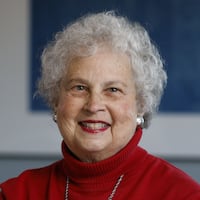To hear Dayton History’s Brady Kress talk about the Newcom Tavern preservation project, visit MyDaytonDailyNews.com
Dayton’s oldest standing structure is in the midst of a $100,000, four-month exterior restoration.
When completed by summer’s end, Newcom Tavern, moved to Carillon Historical Park in 1964, will look more like the way it did 200 years ago when the Newcom family lived and worked on what is now the southwest corner of Main Street and Monument Avenue.
Brady Kress, president and CEO of Dayton History, said the building is perhaps one of Dayton’s most important.
“Its early use as the center of business, government, news and prayer established Newcom Tavern as Dayton’s founding building,” Kress said. “It symbolizes the commitment and sacrifice all of Dayton’s first families made to build this new river town in the Northwest Territory.”
Noted historic preservationist Andy Stewart of Architectural Reclamation in Frankin has been hired for the important job which has been funded by the Iddings Foundation and Travelers Conservation Foundation as well as from smaller gifts. Stewart and his team have worked on historic buildings throughout our region — including the Dunbar House and the Patterson Homestead — and have worked on projects at Carillon Park for decades.
Their current assignment is to return the exterior of Newcom Tavern to its roots by adding wood siding that — according to research — covered the four facades of the original building. Contrary to popular opinion, Newcom Tavern was never a log cabin.
“A log cabin is one that is made of round logs, these logs are hewn and squared,” points out Dayton History’s Alex Heckman, director of education. “The round log cabins were more primitive and intended to be temporary, they were primarily found in the Colonies.”
The wood siding was originally added, explained Heckman, to help provide insulation and protect the log walls. That siding was removed when the old building was about to be torn down in 1894. When workmen discovered the logs underneath, a group of citizens — called the Log Cabin Committee — rescued and moved the building, turning it into a museum in Van Cleve Park in time for Dayton’s Centennial celebration in 1896. Those who’ve viewed it in the years since have seen the logs without the siding.
Dayton History decided it was time to replace the original siding. The process involves treating the logs with a wood preservative and insect repellent, applying oak lath, then affixing the reproduction sash sawn white oak weatherboard with reproduction wrought head nails. Ohio-grown oak trees were harvested last autumn and processed into lumber which has been drying through the winter months.
“The building teaches you a lot,” said Stewart, when asked how he researches a project. “You figure out how the original person did it, that person built it that way for a reason.”
Kress said the current chimney is not historically accurate so in addition to the siding, Stewart will be using locally-sourced stones to build a new chimney face. They are the kinds of stone, said Kress, that would have been available to the Newcom Tavern builder, Robert Edgar, who was charged by the Newcoms with building “the finest house in Dayton” from locally available materials.
All of the work is being done in a manner that can be reversed if future historic preservationists deem it necessary. The building remains open, and visitors to the park can watch the work as it progresses.
Newcom Tavern began as a two-story home in 1796 and originally stood on the southwest corner of Main Street and Water Street (now Monument Avenue). In 1798-99, the Newcoms decided to add rooms that became a tavern, bar, hotel and restaurant. Over the years it also served as Dayton’s first jail, a church, a general store and Montgomery County’s first temporary courthouse.
In 1964, the tavern was moved from Van Cleve Park to its current location. Inside are original items including Mary Newcom’s rocking chair that was made specifically to accommodate her bad back, and a bed built in the early 1800s that belonged to the Newcoms.
Denny Dutcher, a retired teacher from Springboro who volunteers at Carillon Park, said he enjoys bringing history to life by sharing anecdotes about real people like the Newcoms. He said Newcom Tavern is one of the most treasured parts of the park.
“It was like today’s bed and breakfast — you had a place to park your bedroll upstairs on the floor where you slept with other male travelers,” he tells visitors. “You had a place to let your horse graze out back and you could get one of Mrs. Newcom’s meals if you were there at the time when she served. That was all for the sum of 65 cents a day.”
Concludes Dutcher: “If those walls could talk they would tell so many different stories.”
About the Author
